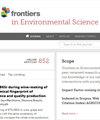Distinct microbial community structures formed on the biofilms of PLA and PP, influenced by physicochemical factors of sediment and polymer types in a 60-day indoor study
IF 3.3
3区 环境科学与生态学
Q2 ENVIRONMENTAL SCIENCES
引用次数: 0
Abstract
Microplastics (MPs) are colonized by biofilm-forming microbes. Biodegradable plastics, popular replacements for traditional plastics, still have unknown biofilm formation characteristics. We conducted a 60-day indoor experiment, where sediment was exposed to traditional MPs (polypropylene, PP), biodegradable MPs (polylactic acid, PLA), and glass beads (GLASS). The microbial communities in the MPs-biofilm were analyzed using high-throughput sequencing. Results indicated that Proteobacteria was the dominant phylum on all substrates, followed by Actinobacteria, and Firmicutes. At the genus level, the majority of microorganisms colonizing PP possessed nitrification and denitrification capabilities, while the dominant bacteria on PLA were capable of degrading lignin, cellulose and carbon metabolism. The genus在为期 60 天的室内研究中,聚乳酸和聚丙烯生物膜上形成的不同微生物群落结构受沉积物理化因素和聚合物类型的影响
微塑料(MPs)会被形成生物膜的微生物定殖。生物降解塑料是传统塑料的流行替代品,但其形成生物膜的特性尚不清楚。我们进行了一项为期 60 天的室内实验,将沉积物暴露在传统 MPs(聚丙烯,PP)、生物可降解塑料(聚乳酸,PLA)和玻璃珠(GLASS)中。利用高通量测序技术对 MPs 生物膜中的微生物群落进行了分析。结果表明,蛋白质细菌是所有基质上的优势菌门,其次是放线菌和固着菌。在属一级,定殖在聚丙烯上的大多数微生物都具有硝化和反硝化能力,而聚乳酸上的优势细菌则具有降解木质素、纤维素和碳代谢的能力。在聚乳酸生物膜上特别发现了能够降解可生物降解微塑料的鞘氨单胞菌属,同时,细菌在聚乳酸上的定殖也间接增加了病原体向人类传播的可能性。冗余分析表明,pH 值和湿度对细菌群落有显著影响。皮尔逊相关热图表明,除盐度外,两种 MPs 生物膜中大多数优势菌属的丰度与沉积物的理化参数(pH、水分、TN、TP)呈负相关。与聚丙烯和聚乳酸相关的微生物群落在沉积物理化性质变化和不同物质基质的综合影响下表现出明显的差异。这项研究进一步证明,当暴露于同一源群落时,微生物在这两种 MPs 上的定殖表现出明显的选择性特征,为探索有潜力的 MPs 降解细菌提供了启示。
本文章由计算机程序翻译,如有差异,请以英文原文为准。
求助全文
约1分钟内获得全文
求助全文
来源期刊

Frontiers in Environmental Science
Environmental Science-General Environmental Science
CiteScore
4.50
自引率
8.70%
发文量
2276
审稿时长
12 weeks
期刊介绍:
Our natural world is experiencing a state of rapid change unprecedented in the presence of humans. The changes affect virtually all physical, chemical and biological systems on Earth. The interaction of these systems leads to tipping points, feedbacks and amplification of effects. In virtually all cases, the causes of environmental change can be traced to human activity through either direct interventions as a consequence of pollution, or through global warming from greenhouse case emissions. Well-formulated and internationally-relevant policies to mitigate the change, or adapt to the consequences, that will ensure our ability to thrive in the coming decades are badly needed. Without proper understanding of the processes involved, and deep understanding of the likely impacts of bad decisions or inaction, the security of food, water and energy is a risk. Left unchecked shortages of these basic commodities will lead to migration, global geopolitical tension and conflict. This represents the major challenge of our time. We are the first generation to appreciate the problem and we will be judged in future by our ability to determine and take the action necessary. Appropriate knowledge of the condition of our natural world, appreciation of the changes occurring, and predictions of how the future will develop are requisite to the definition and implementation of solutions.
Frontiers in Environmental Science publishes research at the cutting edge of knowledge of our natural world and its various intersections with society. It bridges between the identification and measurement of change, comprehension of the processes responsible, and the measures needed to reduce their impact. Its aim is to assist the formulation of policies, by offering sound scientific evidence on environmental science, that will lead to a more inhabitable and sustainable world for the generations to come.
 求助内容:
求助内容: 应助结果提醒方式:
应助结果提醒方式:


